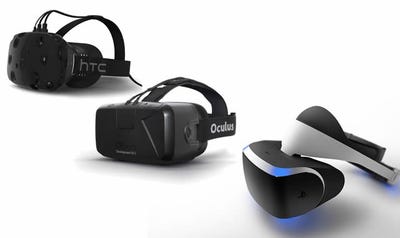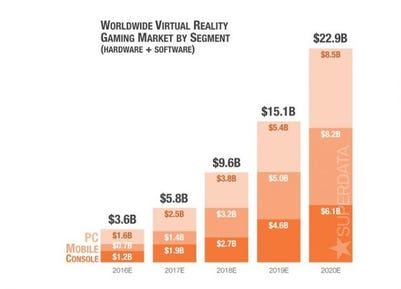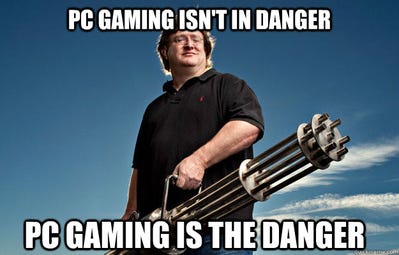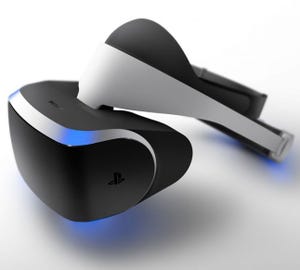
Picture sourced from PS4 Daily
Even though HTC and Oculus have demonstrated themselves to be respected pioneers in the PC VR space, I've observed that this industry will have the strength of diversity and that the market's 2016 sales potential is tiny in comparison to its true opportunity in the not too distant future.
I wrote this article because several analysts and spokespeople have been promoting that VR's grandest future will begin to happen in 2020, and I figured it would be helpful to share some fundamentals to help secure that viewpoint.
There really is a natural order of things, and this article explains why in this author's opinion, the virtual reality market's potential audience is destined to grow to hundreds of millions of PCs within the next three to five years and what the markers are that support this forecast.
Key topics include:
The early VR sales expectations for PC.
Recent analyst and vendor behaviors supporting the forecast.
Requirements for VR viability and mass market potential.
The "killer app" for virtual reality.
A primer on Moore's Law and what it means for PC VR's future.
The Early VR Sales Expectations for PC
Last December, I published an article forecasting that the PC HMD unit sales would be between 300,000 and 500,000 units within a twelve-month period from launch based on available graphics card sales data provided by Jon Peddie Research. This isn't a calculation for sales in 2016, this is just 12 months from launch, and it can reflect staggered launches between brands. These numbers refer to the Oculus Rift and HTC Vive products plus anything else PC based.
I also said that Oculus and HTC and every other PC brand could delay their launch as much as a year or more because the launch would have little to no impact on securing market share. My reasoning is the current audience potential is so limited, there isn't anything to fight over. The sooner the market forces come to grips with this, the industry's path to viability will be much clearer and more secure.

Sheryl Sandberg, COO, Facebook (picture source: fortune.com)
Supportive Market Behaviors
Facebook's latest market developments seem to be adding credibility to the December forecast numbers. It was only a year ago that Mark Zuckerberg described the Rift as only being worthwhile if Facebook could sell between fifty and a hundred million units. Since December, Facebook's Palmer Luckey started Tweeting about having realistic sales expectations, Oculus was effectively dismissed from Facebook's relevant financial projections, and Sheryl Sandberg, Facebook COO, described VR as a ten-year plan. Mark Zuckerberg later described mass marketability happening within ten to twenty years, and Brendan Iribe, CEO of Oculus, most recently predicted that a million units in sales in the lifetime of the Oculus Rift would be a huge success. In March, the Associated Press published an article entitled "Oculus' Virtual Reality Headset to Launch Without Fanfare".
Facebook's developments aren't good or bad; they just reflect that they have to play a fruitful long game because their traditional revenues are too out of scale to be relatable in this space. There is no way for VR to be a material income in such a short time in Facebook's world. Their mid to long term potential is a different story, however, and will be discussed shortly.
Despite both HTC and Oculus having bumpy product launches with delayed shipping and piqued customers, this has little to no impact on my 12 month sales predictions. In fact, the silver lining is that upset customers are a good sign that consumers care and are passionate about VR.

Superdata's Latest VR Sales Expectations (March, 2016, Source: Superdata)
Since December, the analysts have also starting to rethink their numbers. In March, Superdata slashed their 2016 virtual reality sales expectations by 30%; a resulting $3.6 billion in VR revenues instead of the $5.1 billion they projected in January this year. In this author's opinion, their projections are still on the aggressive side, and their expectations that PC would out-value the console in such a short time is difficult to support so early in the game. It might be because the PSVR's scheduled launch is so late in the year (October, 2016) relative to the other players.
.jpg/?width=501&auto=webp&quality=80&disable=upscale)
To date, Strategy Analytics is one of the first analysts I've seen that describes VR product sales in terms of units sold instead of X value in dollars which has limited meaning on its own. In their view, 2016 will only see 1.7 million VR HMD units sold that are designed for PC and video game console. Again, I think this has to do with PSVR's October launch relative to the other players which got released far earlier. Had all the launches been simultaneous, I think the numbers could have been more aggressive.

What this all comes down to is that the VR market has been behaving as though Lamborghini-class gaming PCs are sitting in everyone's basement when this is far from reality. In a best case scenario, there are at most fifteen to twenty million of these units at any one time, and I maintain that only three million of these will be qualified for virtual reality by the end of 2016 - perhaps less.
These numbers are perfectly fine for the traditional hardcore gaming market; especially for a first year product release. Everyone accustomed to working in this space is in good shape. It's the content makers and technology platform businesses that are dependendent on reaching tens if not hundreds of millions of consumers that may need to reshape their thinking and roadmap for the short term.
This is why it's so important to look at 2016 as a proof of concept year for something far greater. Everyone's cup is three quarters full provided the market can see far enough in the distance, and they won't have to look TOO far!
What is Required to Demonstrate Viability and Show Mass Market Potential
For consumer VR to become an industry, it needs two things. First, it needs iron clad proof that consumers want and will buy virtual reality. Not early adopters and pre-sold advocates - I mean customers. This has to be demonstrated with a large measurable purchase, it has to be definite, and the investment has to be significant enough. This is often referred to as "the killer app".
Next, there has to be a quantifiable and sizable audience. Everyone has to be able to throw out a number of potential customers that hold up to scrutiny and is reasonable to reach out to. I think a solid number would be how many PCs are actually qualified for the technology.
By combining the elements of demonstrated purchases of virtual reality and what the potential audience really is, the market will have a solid formula of things to come. Instead of VR being a weak faith-based endeavor, it becomes a promising future that everyone can clearly visualize because they have the market's laws of behavior behind them.

Virtual Reality's Killer App
Bumpy or smooth, the early Oculus Rift and HTC Vive product launches have limited influence in the grand scheme of things, and I mean this in a positive way. To prove demand for virtual reality, all we have to do is look back at how the 3D industry first proved viability. While there was a growing excitement for stereoscopic 3D entertainment and technology, it wasn't until James Cameron's $2 billion hit Avatar that the market got wildly excited about the industry's potential. 3D had their shining white knight that justified it all. Forget about how the opportunity was squandered with divided platforms, crappy 2D/3D conversions, and customer confusion - Avatar was the vision and the proof that the 3D industry needed to move forward. More importantly, Cameron used S3D to help tell the story, and not just for novelty or unnecessary effects.
In the virtual reality world, we too have been talking about our "killer app". Is it a game? A 360 VR movie? A VR broadcast? A metaverse? I say none of the above.

Sony PSVR HMD
Our "killer app" isn't an app at all...it's a brand: Sony. This isn't an endorsement of Sony or a statement that they are somehow better than the rest. I'm only talking about the market's nature and how I think that nature will work. As I've mentioned before, Sony already has a potential community of over 36 million PS4s in the universe. If they achieve a 10% attach rate for their PSVR HMD, that's a solid 3.6 million units in sales within 12 months of launch. Whether it's less or more, it doesn't matter. They are well positioned to sell those units and we are already seeing anecdotal evidence of this thanks to their required launch delay to October so they can meet the required production demands.
Sony also exemplifies a best case scenario where the messaging is 100% about selling VR and not requiring expensive secondary purchases like a powerful computer. Despite the difference in quality and processing capability, Sony showcases everything a PC ecosystem would want and need to sell VR on a wide scale. The PSVR HMD is the "what if" proof of concept for PC, and it just so happens that Sony is fully outfited to deliver very early in the game.
If this forecast is correct, Sony's success is the iron clad proof that there is real consumer demand for virtual reality which is the most important factor of all. Unlike a freebee Google Cardboard or a seeded HMD like Samsung's GearVR, Sony would represent actual sales in a mature platform for a significant price ($400 - $500 US). If there are pronounced VR sales in the Sony world, PC and mobile have every reason to have relative sales in their ecosystems. The killer app is all about proving the demand and follow-through with VR; the choice of platform is a secondary decision.

Source: Paramount Pictures (via meme)
The Benefit of Moore's Law
PS4's likely end of life market size is about 100 million units. I maintain that through 2016, the number of VR capable gaming PCs is about three million units, and the dedicated gaming PC maxes out at between 15 to 20 million units in a few years. I appreciate that these numbers look so ridiculously far apart, it's a wonder they are even in the same paragraph.
Remember Moore's Law! The amount of circuitry on a chip doubles every two years; and this is strongly bound to delivered performance. It takes about three to five years for the world's top graphics boards to be in a mass marketable category; eventually advancing to the point of having a near-equivalent as a CPU/GPU on a single die.
According to Jon Peddie Research, there were 314 million embedded GPUs sold in 2015 - and that doesn't include console. Unlike discrete graphics boards (also known as Add in Boards or AIBs), embedded GPUs represent one to one relationships between the graphics chip and the motherboard and therefore the PC. While the embedded GPU mass market doesn't yet have the required VR horsepower, I expect to see this readily available by 2020, and there will be plenty of sequential market growth leading up to that. This is still a bit simplistic because the CPU and memory has to add up equally well, but once the basics are there, the market potential grows by hundreds of millions each year.
However, there is a hefty price for this mass market opportunity. The discrete graphics boards will always be magnitudes better than anything you would find on an embedded motherboard five years from now. The two sides are never one and the same. So mass market gamers are either going to have to play titles using processing power requirements that are at least five years old, or mass market VR will have a casual gaming category and an advanced gaming category. AMD and others are now proposing a segmentation categorization to identify just such content.
So what does this mean for the PC market stakeho


































